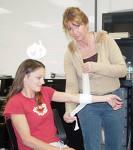Health & safety training: Ensure your staff receive it.
 If an accident occurs, one of the first things the HSE will investigate is whether you provided adequate and correct training. In 2 recent fatal accidents, for example, the provision of training was found to be lacking and the companies were fined £361k and £62k.
If an accident occurs, one of the first things the HSE will investigate is whether you provided adequate and correct training. In 2 recent fatal accidents, for example, the provision of training was found to be lacking and the companies were fined £361k and £62k.
So this week I am going to explain what you, as an employer, may need to do to ensure your employees receive appropriate health and safety training. I also aim to give advice on who may need training, what form the training may take and how to organise it. This article will hopefully be useful to employers, employees and their representatives.
If you require any further help on these, or on a subject not included, please feel free to contact me on 01458 253682, email or via our Facebook page or by Twitter
This week’s recent HSE cases are looking at two accidents that shouldn’t have happened
- One gas boiler that Neil Walker passed as safe was subsequently found to be ‘Immediately Dangerous’ and was potentially leaking poisonous carbon monoxide into the tenants’ property
- His glasses were blown off and he suffered alkaline burns to his eyelids and ulcers to both corneas, including grazing and burns to his legs.
Health & safety training: Ensure your staff receive it.
Over 200 people are killed each year in accidents at work and over one million people are injured. Over two million suffer illnesses caused by, or made worse by, their work.
So, preventing accidents and ill health caused by work should be a key priority for everyone at work. As the owner or manager of a business you know that competent employees are valuable. Your business probably depends on them.
What is training?
Training means helping people to learn how to do something, telling people what they should or should not do, or simply giving them information. Training isn’t just about formal ‘classroom’ courses.
Within many industries, there is growing concerns about the level of competence and high expectations of newly trained/qualified operators. What makes someone more employable and valued is their experience gained through on the job training & consolidation, and non formal training in the form of ‘continuous professional development’ (CPD).
In the professions, great importance is placed on lifelong learning. Without this learning, the knowledge gained from innovation and work experience will not spread throughout your industry. General working experience is recognised as valuable evidence of workers employability. To help demonstrate this, the evidence needs to be recorded. Currently, there is no national scheme in treework for recognising or recording this. In the 21st century, CPD is vitally important to your employees, your business and your client. If CPD is managed effectively then your business benefits from increased profitability and competitiveness. You have a more efficient & flexible workforce and are able to better utilise your staff resources.
Your members of staff become more motivated, remain loyal and committed. Management of CPD allows you, the employers, to attract, recruit & retain the best people. By demonstrating workforce competence your business is given direction and an enhanced image. This is not just about health and safety. Increasingly, clients are demanding evidence of ability to undertake contracts to a suitable quality, and businesses have been shown to benefit from being able to provide this information, by winning contracts over other companies.
Within the professions, CPD is seen as the systematic maintenance, improvement & broadening of professional knowledge. Greater understanding and improved skills lead to the development of personal qualities deemed necessary to undertake professional and technical duties, throughout one’s working life. Keeping up to date with new technical & business related subjects in your profession is important and it’s about being even better at what you do.
Why provide health and safety training?
Providing health and safety information and training helps you to:
- ensure that people who work for you know how to work safely and without risks to health;
- develop a positive health and safety culture, where safe and healthy working becomes second nature to everyone;
- meet your legal duty to protect the health and safety of your employees.
Effective training:
- will contribute towards making your employees competence in health and safety;
- can help your business avoid the distress that accidents and ill health cause;
- can help you avoid the financial costs of accidents and occupational ill health, such as damaged products, lost production and demotivated staff. Don’t forget that your insurance might not cover all these costs.
What does it say in the law?
The Health and Safety at Work etc. Act 1974 requires you to provide whatever information, instruction, training and supervision as is necessary to ensure, so far as is reasonably practicable, the health and safety at work of your employees.
This is expanded by The Management of Health and Safety at Work Regulations 1999, which identify situations where health and safety training is particularly important, e.g. when people start work, on exposure to new or increased risks and where existing skills may have become rusty or need updating.
Like many employers, you may not be in a position to provide this training on your own, in which case you will need competent help. That is why The Wilkins Safety Group provide training courses, both ‘open’ and ‘in house’ courses.
Safety Representatives and Safety Committees Regulations 1977 and the Health and Safety (Consultation with Employees) Regulations 1996 require you to consult your employees, or their representatives, on health and safety issues. Representatives appointed under either of these sets of regulations are entitled to time off with pay for training in their duties.
The Health and Safety (Training for Employment) Regulations 1990 ensure that learners doing work experience are covered by health and safety law.
There are a number of other regulations that include specific health and safety training requirements, e.g. asbestos, diving and first aid.
What about self-employed people?
A person working under your control and direction is treated as self-employed for tax and national insurance purposes, they may nevertheless be treated as your employee for health and safety purposes. You need, therefore, to take appropriate action to protect them.
If you do not wish to employ workers on this basis, you should seek legal advice. Ultimately, each case can only be decided on its own merits by a court of law.
Who needs health and safety training?
You do! Whether you are an employer or self-employed, are you sure that you’re up to date with how to identify the hazards and control the risks from your work? Do you know how to get help – from your trade association, your local Chamber of Commerce, or your health and safety enforcing authority? Do you know what you have to do about consulting your employees, or their representatives, on health and safety issues? If not, you would probably benefit from some training.
Your managers and supervisors do! If you employ managers or supervisors they need to know what you expect from them in terms of health and safety, and how you expect them to deliver. They need to understand your health and safety policy, where they fit in, and how you want health and safety managed. They may also need training in the specific hazards of your processes and how you expect the risks to be controlled.
Your employees do! Everyone who works for you, including self-employed people, needs to know how to work safely and without risks to health. Like your supervisors, they need to know about your health and safety policy, your arrangements for implementing it, and the part they play. They also need to know how they can raise any health and safety concerns with you.
Contractors and self-employed people who may be working for you do! Remember, these people might not be familiar with your working environment and safety systems that you have put in place for regular employees.
You should:
- take into account the capabilities, training, knowledge and experience of workers; and
- ensure that the demands of the job do not exceed their ability to carry out their work without risk to themselves and others.
Some employees may have particular training needs, for example:
- new recruits need basic induction training into how to work safely, including arrangements for first aid, fire and evacuation;
- people changing jobs or taking on extra responsibilities need to know about any new health and safety implications;
- young employees are particularly vulnerable to accidents and you need to pay particular attention to their needs, so their training should be a priority. It is also important that new, inexperienced or young employees are adequately supervised;
- employee representatives or safety representatives will require training that reflects their responsibilities;
- some people’s skills may need updating by refresher training.
Your risk assessment should identify any further training needs associated with specific risks.
Useful ‘Toolbox’ talks.
Of course it costs money sending employees away on day long courses, so it may not be an attractive prospect. However, what you should be considering is sending them on full courses at the start, such as a general safety awareness course. This should then be followed up by regular short ‘Toolbox’ talks which can be run on site or over a cup of coffee. These ‘Toolbox’ talks are meant to be used as refresher courses on individual topics that were covered in the earlier day long course. Such as PPE, COSHH etc.
We are running courses
The Wilkins Safety Group has been running a number of courses at Taunton Racecourse, he next being held on the 18th April – see separate notice. We are also looking to run General Health & Safety Awareness courses, First Aid courses, Risk Assessment courses, Asbestos Awareness courses, Manual Handling, CDM courses and Fire awareness courses throughout the year.
If you have any questions about training or would like us to run a particular course for you, call Jon Wilkins of the Wilkins Safety Group on 01458 253682 or email him.
Remember Your Business is Safer in our Hands
Training
We are running new courses again in 2016 and the dates and details of the latest courses are listed below they are:
- Re-qualification First Aid at Work
- CDM Regulations 2015 – For the Smaller Builder
- Asbestos Awareness
- CDM Regulations 2015 – An Awareness Course
But remember we are still available for running “In House” courses and we have now also added a new training service for our customers.
Site Manager Safety Training Scheme (Part of Construction Skills “Site Safety Plus” Suite of Courses)
We have formed an association with a local company TQ Excel who are one of the UK’s leading providers of accredited training to the highways sector of the construction industry. AS a result of this we can now offer the SMSTS (Site Management Safety Training Scheme)
The Site Management Safety Training Scheme forms part of the Construction Skills (CITB) Site Safety Plus range of courses which are highly regarded within the construction industry.
The 5 day training course is aimed at site managers wishing to develop a more in depth legal, moral and social understanding of their role and also teaches delegates how to manage on-site health and safety in accordance with current legislation.
We also offer the 2 day SSSTS Training Course (Site Supervisor Safety Training Scheme) which is a 2 day course aimed at those with on-site supervisory responsibilities.
We also can now offer NRSWA courses.
These qualifications are for those involved in the Excavation and Re-instatement of the highway and are specified under the New Roads and Street Works Act 1991. They are a legal requirement for “statutory undertakers” (i.e. Utility Contractors) and for those working under “section 50 licenses” (Drainage works etc).
Where works are subject to the Act there must be a minimum of 1 qualified operative on every site that is qualified for the operations being carried out and there must be a Supervisor available to visit the site at least on a daily basis.
The qualifications are also often specified by client organisations and local authorities when appointing contractors for works involving excavation or reinstatement of the highway for other purposes.
The first of our courses are:
Re-qualification First Aid at Work
This First Aid at Work Refresher course is designed for anyone who has previously completed the 3 day First Aid at Work qualification and needs to renew their skill-set and certification. This refresher lasts 2 days and secures the delegates’ qualification for a further 3 years before the course will need to be retaken.
Updated to cover the control of catastrophic bleeding
SYLLABUS
- Course introduction.
- Legal compliance.
- Managing incidents.
- Examining a casualty.
- Conscious/unconscious casualties.
- Treating a casualty.
- Further emergency action.
- General common illnesses.
- Basic life support.
- First aid kits/equipment.
- Recording/reporting injuries.
Course Duration: 2 Days
COURSE REF DATE(s) LOCATION
WSG. RFAW. 1601 14th & 15th April 2016 6 Amor Place, Taunton, Somerset TA1 4SG
The all-inclusive rate of £165.00 + vat per delegate will be payable at the time of booking.
Your staff can attend three months before the expiry date on their certificate and still retain the month of expiry on their new certificate.
They must renew no later than 28 days after their expiry date.
CDM Regulations 2015 – An Awareness Course
Course Objective Training /CPD and APS Certificates
The Construction (Design and Management) Regulations 2015 (CDM 2015) come into force on the 6th of April 2015, and will apply to all construction projects in the UK incl. Domestic projects.
This CDM 2015 awareness training course has been developed to provide all duty holders with an understanding of their role and responsibilities under CDM 2015.
Seminar Outline
- Introduction to CDM 2015
- Notification
- Client Duties and Domestic Clients
- Principal Designer Duties
- Principal Contractor Duties
- Designer Duties
- Contractor Duties
- CDM Documentation
- Benefits of Attending
These courses give an overview of the requirements for Clients, Principal Designers, Principal Contractors, Contractors, Designers and Workers, and how the regulations apply to construction projects.
An individual who successfully completes this CDM2015 Awareness Course may claim points towards membership of the Association for Project Safety – APS
Course Duration: 1 day
COURSE REF DATE(s) LOCATION
CDM2015 1601 Monday 18th April 2016 Taunton Racecourse, TA3 7BL
Fee: £170 to include Course notes, mid-morning & afternoon refreshments, Finger buffet lunch, a Certificate of Training and APS Certificate (Fee subject to VAT)
If you have any questions about these courses or any other training or would like us to run a particular course for you, call Jon Wilkins of the Wilkins Safety Group on 01458 253682 or email him.
